#osteoarchaeology
Explore tagged Tumblr posts
Text
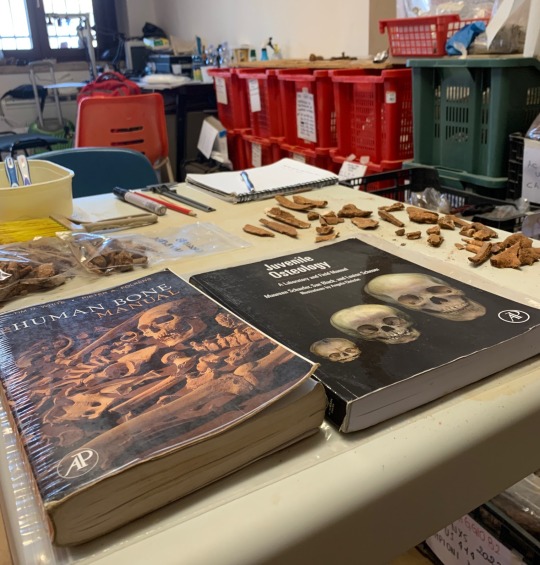
July was as precarious and as messy as my working desk during field season
#archaeology#bioarchaeology#anthropology#physical anthropology#studyblr#osteoarchaeology#phdjourney#academia#study#phdblr#field archaeology#excavation#bioarchaeology on site
139 notes
·
View notes
Text
the problem with being friends with osteoarchaeologists is sometimes you catch them staring at you and you just know they are thinking about what your skull looks like without all the flesh
376 notes
·
View notes
Note
Favourite 'weird' or obscure sub-discipline of archaeology?
Oh man I have so much respect for any of the really niche disciplines, but the bones people (both animal and human) deserve a shout out. @wafflelovingbatgirl I could never do what you do. Bones confuse me so hard. There are just so dang many of em...
-Reid
31 notes
·
View notes
Text



‘Ancestors: The Prehistory of Britain in Seven Burials’, by Professor Alice Roberts
#ancestors#alice roberts#professor Alice Roberts#archeology#osteoarchaeology#digging for Britain#just finished#reading#books#history#british history
9 notes
·
View notes
Text
that fucked up archaeological urge to skeletonise and sex your own skull
#own post#convinced that i (a cis woman) would score an overall 4#and thus be considered male in an osteoarchaeological analysis#i just got those male qualities about my skull y’know
3 notes
·
View notes
Text
i'm literally never more productive than when i'm procrastinating something. this weekend, i did a mini road trip with my best friend and his boyfriend, finished a homework assignment, read a pretty big chunk of my current book, paid my tuition, went for a hike, hung out with my aunts and my mom for a few hours, and am currently figuring out how to apply for a passport. all to procrastinate on writing the jemily fic
#i need motivation lmao#i'm really excited to get my passport though#i'm gonna use it to apply for osteoarchaeological field school in spain next summer#but if i don't get in then i'm gonna try to convince my parents to let my go on a trip to celebrate graduating university#i'm thinking maybe washington dc or something#i wanna visit the smithsonian museums so badly
0 notes
Text
as much as I love osteoarchaeology, I’m not sure I could do it. I’d just be standing there looking at a badly healed break on a femur from the Paleolithic era thinking “ow. owwwww. yeowch. ouchie.”
#someone breaks their leg in the modern day and I have sympathy for them#but imagining the agony of having these serious wounds in a time before basic medicine or advanced painkillers?????#sympathy pain immediately.
128 notes
·
View notes
Text
The fact that everything in archaeology/bioarchaeology is all about the context makes my weird neurodivergent brain very happy! Every bit of information is necessary, and there's always a new thing to learn!
#archaeology#bioarchaeology#anthropology#physical anthropology#bioarchaeology of adolescence#bioarchaeology of childhoood#archaeology of childhood#study#studyblr#phdblr#phdjourney#osteoarchaeology
87 notes
·
View notes
Text
Do not lick the bones, the bones will not lick you
#osteoarchaeology#osteology#light academic aesthetic#chaotic academia#anthropology#bio anthropology#biology#archaeology
52 notes
·
View notes
Text
9/30 What remains
(Previous) | (Index) | (Next)
⛬
We return to the movie that I’m not giving a jokey intro to this time, Prometheus.
When I was in archaeological field school, we were digging in an area that had been continuously inhabited since the Neolithic period. Untold numbers of people had lived there through the ages.
And so it wasn’t entirely unexpected when someone told the professors that a construction crew across the street had just dug up a human skull.

(https://www.standard.co.uk/news/uk/work-begins-to-excavate-45-000-skeletons-from-hs2-site-at-london-euston-a3972926.html )
One of the grad students slapped on a dayglo vest and hard hat, and ran over there to speak with the crew. Undergrads were not allowed anywhere near the site, simply because of the liability risk. But the bones themselves? We weren’t allowed to touch them. They went right into boxes for a specialist to take care of.
All told, remains from 18 skeletons were found, twelve of them children. They’d been there for about eight hundred years. The professors said the construction crew was diffing on top of a medieval churchyard. They’d dug a hole to connect up the utilities, and their trench went right up to the wall of the former church. You could tell that, the professors said, because unbaptized children would’ve been buried under the eaves of the church: rainwater falling from the eaves was thought to be sanctified, so they’d be blessed every time it rained.
The construction crew wasn’t actually obligated to tell anyone about the bones. There was no legal requirement–the dead were everywhere there. As long as there was no reason to suspect a murder, people could just dig.
But because they did stop, just long enough for the bones to be retrieved, those skeletons would be examined, cataloged, and would either be held in an osteoarchaeological collection for further research, or reburied. There was no strong legal or social pressure one way or the other. That’s not universal–some peoples forbid the practice of handling and studying human remains, or require that remains be reinterred with the most culturally appropriate religious rites that can be provided. There is a lack of international or even regional consensus on what to do in these situations.

(https://railuk.com/rail-news/the-archaeology-of-hs2/)
And there are a lot of places where the wishes of descendants and local cultures have not been honored by archaeologists. The twenty year fight over custody of the bones of Kennewick Man (or the Ancient One) is one notable, hard-fought win for repatriation and reinterment of human remains, and there are many, many cases that have been far worse, that are still worse.
But where we dug, the relevant ethical standards for osteoarchaeologists stressed that “[b]iological remains, particularly human remains, of any age or provenance must be treated with care and dignity.”
We students never saw the bones. We didn’t need to, frankly, it would have been incompatible with those values. Is this how it’s handled everywhere? No. And most of the time, our dig was a very casual and lively place. But these professors were trying to start us out with the best ethical standards they could, which I am grateful for.
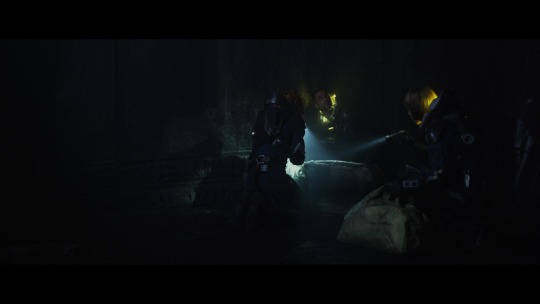
That’s the context that was running through my head as I watched Prometheus. Movies tend to treat dead bodies with far less reverence. They often carry some sort of emotional weight–fear, disgust, grief, or even excitement or humor. In violent movies, they’re set dressing, less important than the main characters–unless one of them was a main character. I chafe at that distinction, sometimes, but I’m not squeamish about movie violence. Two of my favorite movies of the year prior had been The Raid and Dredd. Two serendipitously similar action movies where death was relentless, graphic, and cheap–content warning in both links, by the way.
Both movies had carried me through because they were consistent on what they were throughout. I didn’t expect anything more sensitive from movies about action-fantasy cops. Prometheus had already lost me, and it was about archaeologists. Ones who professed a belief that they were there to meet their makers.
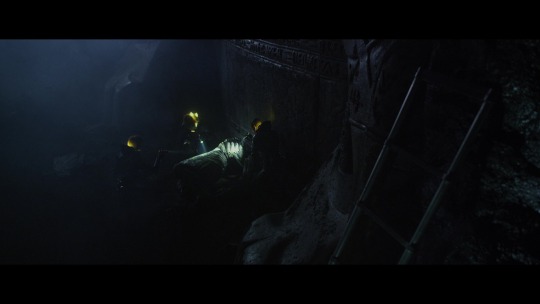
And so I found the way they treat the discovery of an alien body to be utterly galling. Despite the fact that I didn’t expect anything better from them by this point, I still wasn’t willing to meet the movie where it wanted me to be. I wasn’t feeling their excitement, trepidation over what else they were going to find next, or any voyeuristic excitement over how screwed they obviously were–any of those might have been the intended emotion, I’m honestly not sure what sort of horror movie Prometheus was trying to be at this point.
I was just seething that they were touching the body. Sticking probes into it. That was bad enough.
We haven’t even gotten to what they do to the head yet.
⛬
(Previous) | (Index) | (Next)
⛬
Citations for alt-text:
All links listed in-line below the images this time.
#prometheus 2012#prometheus (2012)#I'm trying to analyze the movie from within its own goals and parameters when that's most useful#but I also want to give space for topics like this#my takeaway was definitely not what they intended#but people often don't think carefully about the bones of strangers#and what their treatment means
43 notes
·
View notes
Text
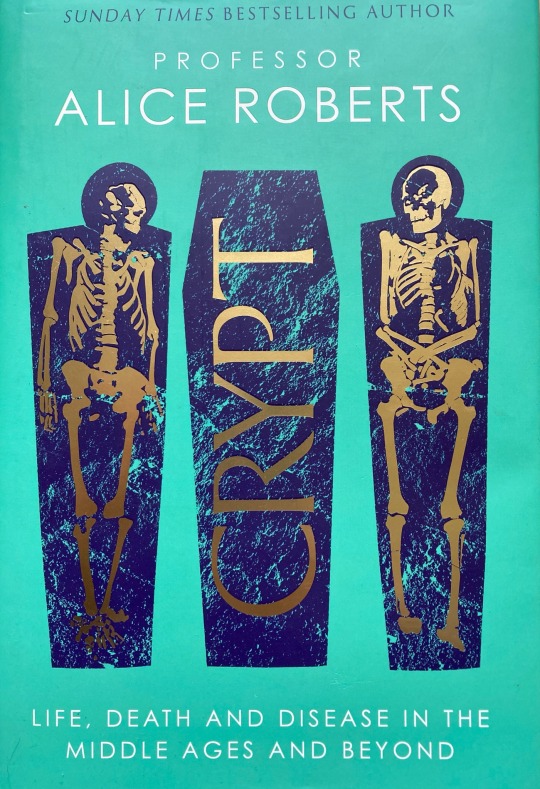
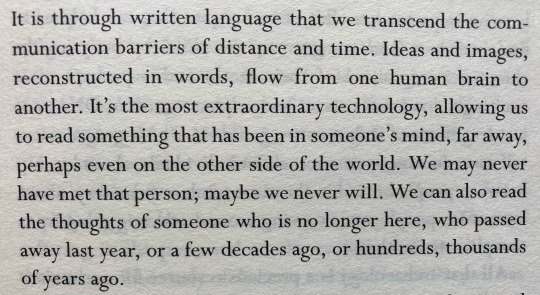
#just finished#reading#books#alice roberts#dr alice roberts#crypt#history#british history#osteoarchaeology#archeology#plague#disease#Middle Ages#communication#language
2 notes
·
View notes
Note
For the truth or dare ask game: 🔪
��� ⇢ what's the weirdest topic you researched for a writing project?
Hmm, probably bones.
I had to read some papers on the impact of prolonged strain on skeletal remains for Untarnished because my osteoarchaeology is a bit rusty.
21 notes
·
View notes
Text
15 people, 15 questions
I was tagged by the delightful @thetragicallynerdy thank you friend!!
Are you named after anyone?
Nope! None of my past or present names have been any actual person
2. When was the last time you cried?
I have no idea, I'm not much of a crier tbh. Maybe my birthday because several factors conspired to make me have a godawful day actually lmao
3. Do you have kids?
Hell no. I don't ever want kids, and I know that even if I wanted them I wouldn't be able to parent them as they deserved so I shouldn't have them
4. What sports do you play/have played?
I've been doing archery for the last eight years, and English longsword for about 18 months. I also swim sometimes. In the past I've done irish dance, softball, trampolining and gymnastics
5. Do you use sarcasm?
So much lol
6. What's the first thing you notice about people?
idk... maybe their accent? meeting a new person is guaranteed to play havoc with my auditory processing issues
7. What's your eye colour?
Brown
8. Scary movies or happy endings?
omg happy endings I am a giant weenie
9. Any talents?
I can do all sorts of party tricks with my stupid bendy joints but mY dOcToR sAyS i ShOuLdN't
10. Where were you born?
England - Norfolk specifically
11. What are your hobbies?
Too many!! Drawing, painting, crochet, baking, archery, sword class, reading, going for walks, swimming, sewing, knitting, journalling...
12. Do you have any pets?
No :'(
13. How tall are you?
5'6"
14. Favourite subject in school?
I'm still in school as a PhD student in osteoarchaeology so... that. I used to like chemistry, history and maths in school-school
15. Dream job?
One of the big museums says "here we'll pay you for your entire career and you can go through our storage to catalogue and analyse all of our human remains, have fun" because there's SO MUCH in museum storage that's completely inaccessible bc half the time the museum doesn't even know they have it or where it's from or it's never been properly looked at. I'm pretty sure the natural history museum alone has enough to fill a 40 year career and it makes me so sad
I'm going to tag @dashing-hyphen @oluwandesorange @beccarooni @rattusn0rvegicus @salem-speaks @girlscience @knifewieldingenby and @frigoriferoarancione to join in if you want to!!
#thanks for the tag h <3#how did this turn into another post of me rambling about bones. anyway#tag game
6 notes
·
View notes
Note
Hey I’m curious what’s a common misconception about one of your favorite interests
i mean my main special interest is ancient rome and i think the way people generally view ancient rome and the ancient world as a whole is absolutely riddled with deep set misconceptions that i could genuinely talk about for hours lmao. i specialise in caesar and i could fill an entire book on things people get wrong about him. i don't trust 90% of what i read about that man. people don't know shit
i also think a similar thing applies to a lot of the osteoarchaeological things im interested in. there's just so much misinformation out there that people seem to love perpetuating. i see a LOT of people who genuinely believe that skeletal remains that show physical signs of disease can help us understand the general health of an entire population; or that they represent the sickest in society when a lot of the time it's the exact opposite (i.e. the whole concept of the osteological paradox). but i do not want to bore anyone by getting into this <3
i already spoke about this before but another of my main interests is the scottish wars of independence and there's A LOT wrong with the general perceptions of william wallace and robert the bruce that annoy me there. i made a post about it somewhere i think
anyway this is too long oops i am sorry
3 notes
·
View notes
Note
Okay so i didn't see the questions i was looking for or missed so original questions ahead
~If you could slap someone from TOA (not Zeus) who would you pick? If you could hug someone from TOA (not Apollo) who would you hug?
~Which overused cliches ot tropes you can't get enough of?
~If protagnists' of the last book you read was put in the last game you played how much trouble they would be in?
~If any other god/godess from Greek/Roman pantheon could get their own version of TAO which god/godess you would pick?
~You find yourself 30 years into future and you're allowed to google one thing before going back to your time, what would google?
Well those are some unusual and unexpected questions - but also fascinating ones!
Let's go through these in order...
If I could slap someone from TOA (who isn't Zeus), who would I pick? Immediately narrowed this down to the Triumvirate because they're all assholes who would deserve it. I think I'll go with Nero, though - he's the most persistently irritating one (although Caligula comes very close with his Jason-killing)
If I could hug someone from TOA (who isn't Apollo), who would I pick? Will. I mean, if I can have more than one answer I'm adding Austin and Kayla to the mix, but come on, Will needs that hug so badly. So badly. And I know he has Nico to provide them already but that isn't going to stop me from supplying more.
Which overused tropes/clichés can't I get enough of? Hurt/Comfort in general, especially on the whump front, but someone getting hurt shielding someone else with their body and the panic that comes after it is so, so good. I need to do more of that it's been a while... eyes my newest potential victim. You. You fit.
If the protagonists of the last book I read were put in the last game I played, how much trouble would they be in? Okay, last book I read was Rick Riordan's Daughter of the Deep (which is absolutely fantastic 10/10 highly recommend). Last game I played was Age of Empires II: Definitive Edition. ...It would depend what map the kids were on, really. Any of the land-based maps (which is most of them), then they'd probably struggle a little but they're resourceful, tenacious and very intelligent so I figure they'd manage to conquer the map given enough time. Any of the sea-based maps they would thrive - after all, that's basically the same premise as their canon book!
If any other god or goddess from the Greco-Roman pantheon could be included in Riordanverse, which would I pick? Actually a hard question because Rick's covered most of the ones I know pretty substantially. The one that springs to mind for me is Eris, the goddess of discord and in some versions of mythology, Ares' sister. It would be very interesting finding ways to integrate her into the existing dynamics we know exist, especially with Ares himself!
If I was sent 30 years into the future and was allowed to google one thing before being sent back, what would I google? Hmm... That would be 2053 which is certainly a decent chunk into the future! I don't think I'd want to google anything about events or anything because then I'd be stuck with future knowledge I can't do anything else about. I might just google some niche osteoarchaeological question to see what the future makes of it compared to now. That seems like a safe enough thing to have foreknowledge of, right..?
4 notes
·
View notes
Text

Third day being a "just a girl hanging around to enter a PhD program":
I'm studying new adolescent individuals to continue my graduate research, and the ones I'm currently analyzing are from a Bronze Age site in Italy (my favorite time period to work with!!). One of the skeletons belongs to a young woman who presents signs of a possible pregnancy. Although parturition markers are quite tricky to identify and they cannot tell with absolute certainty that a pregnancy occurred, it still amazes me (even after so many years in this field!) that we can hypothesize such an intimate detail about the life of someone who lived so far away in the past.
On a less uplifting note, I feel like my journey into this phd life will be a lonely one. Usually I’m the one motivating my colleagues but I rarely receive back the same energy back. I’m quite solitary and independent, I don’t mind doing my own thing but sometimes I wish I could receive more external support.
#bioarchaeology#anthropology#physical anthropology#archaeology#bioarchaeology of adolescence#bioarchaeology of childhoood#archaeology of childhood#osteoarchaeology#osteology#study#studyblr#phdblr#phdjourney
98 notes
·
View notes